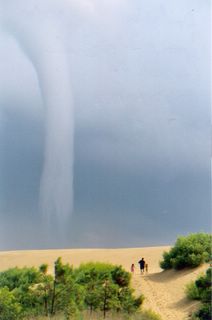When is a good time to find shells? (O B Sentinel)
posted @ 11:38 PM
-
0 comments
Ask the Aquarium: When is a good time to find shells?
BY SHERRY WHITE

Shelling is a favorite pastime for many beach strollers and an earnest pursuit for serious collectors. Photo by John Mauser
A. Shelling is best an hour or so before and after low tide, especially during spring tides on new and full moons. When combing the beach, remember to check along the high tide line. Storm tides and full-moon tides often deposit prime specimens at the foot of the dunes.
Seasonally, the best shelling on North Carolina beaches is in winter, when strong winds and rough seas bring shells on shore - plus, fewer people are walking the beach, which increases the odds of finding prize specimens. Early in spring and fall are also good times, and anytime after a storm offers good shelling potential.
Several areas of North Carolina's coast have earned shelling reputations; Hammocks Beach State Park, Cape Lookout National Seashore, Shackleford Banks, Ocracoke Island and Cape Hatteras National Seashore. You'll notice all these are island beaches rather than mainland beaches. Waves reach these islands first, so there's a better chance of finding interesting shells. Also, because the islands are accessible by boat or ferries only, with the exception of Cape Hatteras, there are less people combing the beaches.
Cleaning and preserving your prize involves a series of simple steps. First, make sure no animal remains inside. There are two reasons for this: One, the animal will die if removed from its marine environment, and two, the shell will stink like the dickens for weeks.
Wash and flush the shells thoroughly (their spirals can hold an amazing amount of sand), and clean off any algae or barnacles (leave barnacles if you like them). Some suggest soaking shells in a light mixture of bleach and water. This works well if the shell is naturally white, otherwise the shell's color will fade. Dry shells completely in a well-ventilated, shady area. Avoid drying in the sun, as sun fades colors. To retain color, apply a very thin coat of mineral oil after the shell is thoroughly dry.
Most importantly, never collect live shells, or shells that have an animal living inside, such as a hermit crab. Hermit crabs are interlopers and often inhabit what appear to be empty shells. And, avoid taking live sand dollars. Living sand dollars are covered with a brownish or greenish fuzz. If they are white, they are no longer alive and are free for the taking.
Information provided by the North Carolina Aquarium at Pine Knoll Shores. The Aquarium at Pine Knoll Shores is closed for expansion, however offices are operating out of Atlantic Station Shopping Center, Atlantic Beach. The state operates three public aquariums; one in Pine Knoll Shores, another at Fort Fisher and a third on Roanoke Island. The aquariums are administered by the North Carolina Department of Environment and Natural Resources, and are designed to inspire appreciation and conservation of North Carolina's aquatic environment. For more information about the Aquariums, log onto http://www.ncaquariums.com, or call 800-832-FISH.








0 Comments:
Post a Comment
<< Home